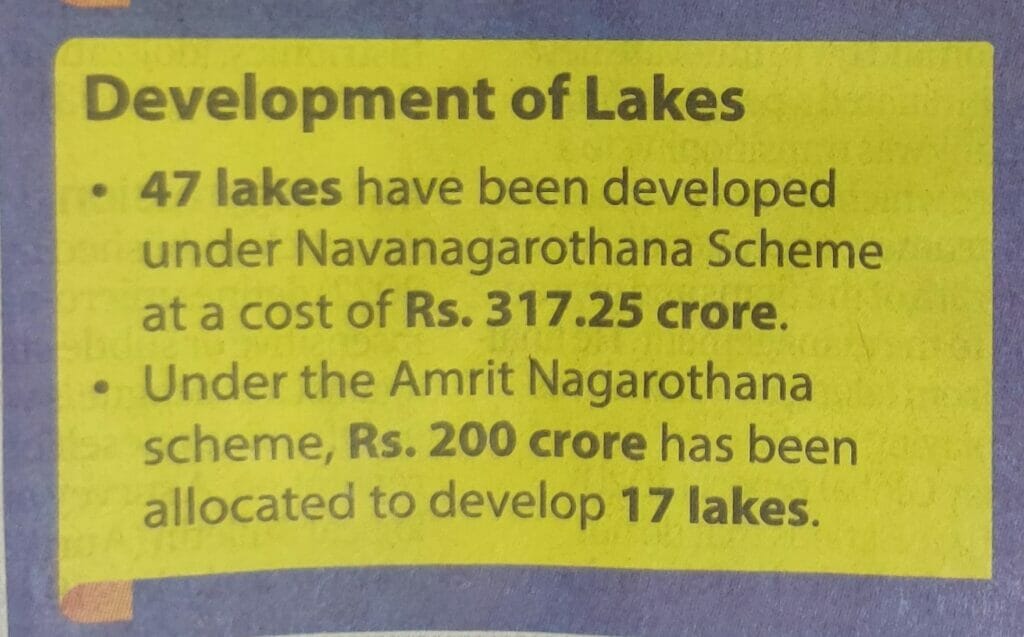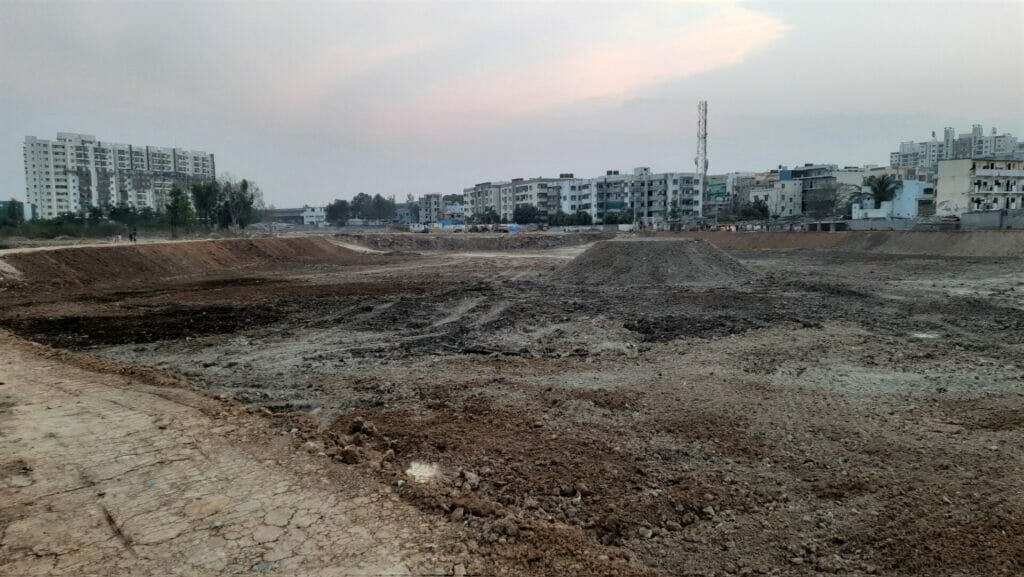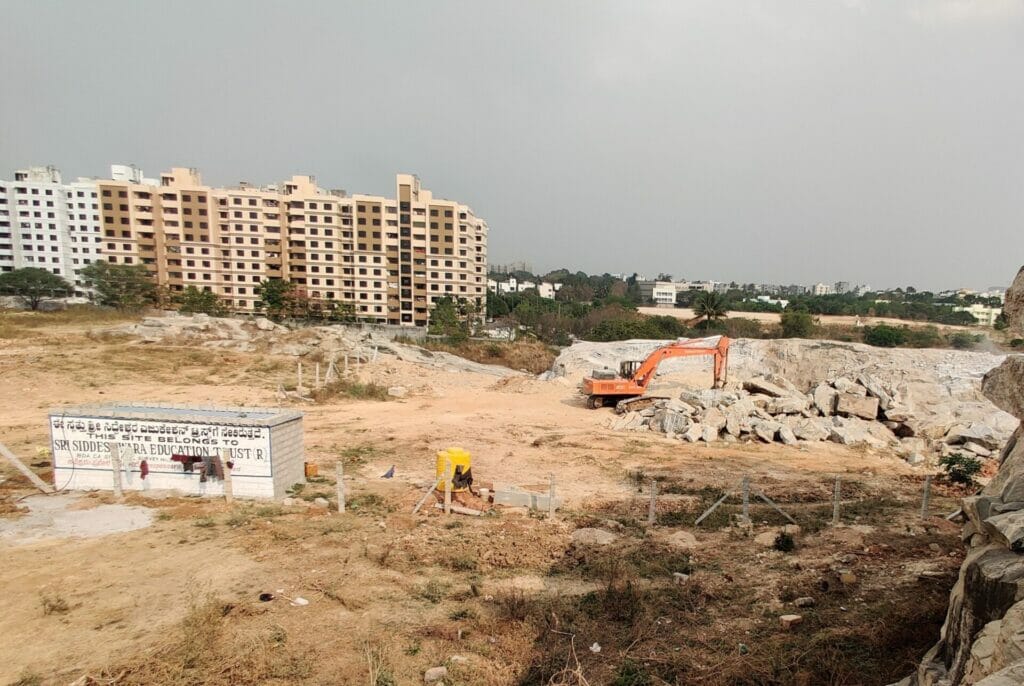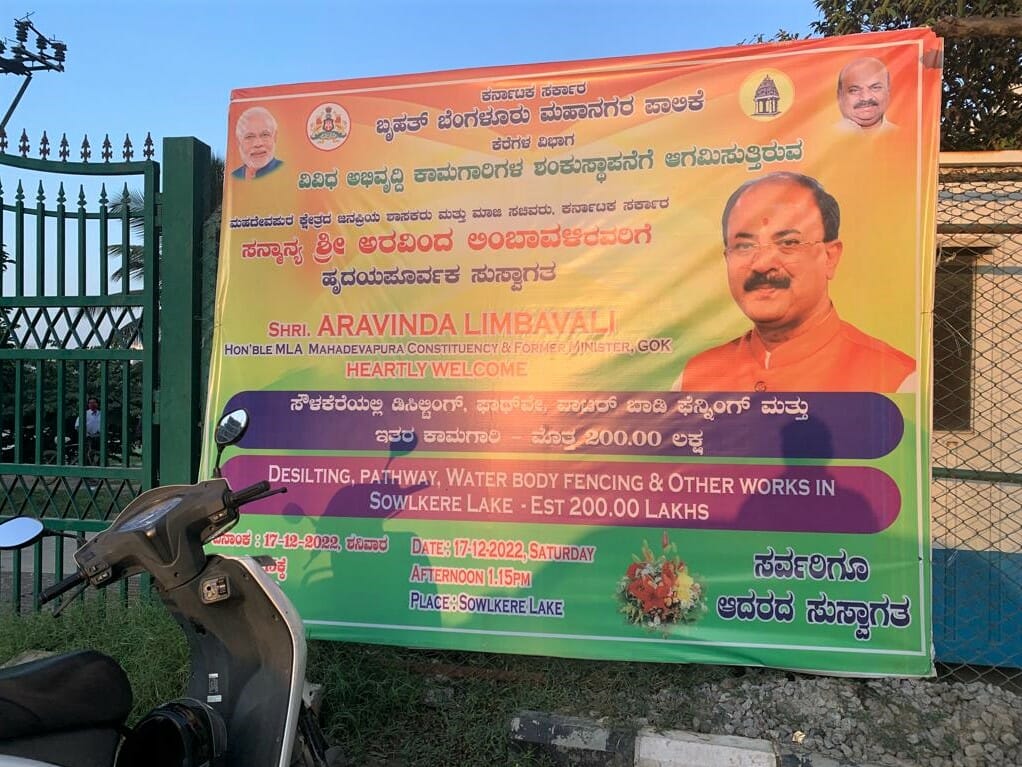In early January 2023, with the elections drawing near, citizens across Bengaluru began waking up to their neighbourhood lakes being drained, dug up and desilted in preparation for restoration.
The state government had allocated various grants for lake restoration across the city. According to a full page advertisement the government placed in the Deccan Herald, 47 lakes had already been developed under the Nava Nagarothana scheme and 17 were to be developed in 2023 under the Amrutha Nagarothana scheme during the 2022-23 budget.

We previously reported that this claim was stretching the truth at best. Money had been allocated under various schemes for lake development, but the funds were disbursed in a piecemeal fashion. Thus, most lakes were still works in progress.
However, the funding is not the only issue with lake management in the city. While MLAs from both sides of the aisle have claimed credit for lake restoration work, the process itself remains opaque. Lake development works across the city have led to fears of biodiversity loss, wasteful public expenditure, and even encroachment of lakes.
The Urban Development Department (UDD) approved the development of 67 lakes in June 2022; and under the Amrutha Nagarothana scheme in 2022-23. At least 59 lakes were also scheduled for development under the Nava Nagarothana scheme introduced in 2019. Owing perhaps to the long tender process, the work in many of these lakes finally began in January this year. There is only one problem: There is no information in the public domain.
Concerns across the city
As part of reporting for this story, I asked Twitter users to tell me about lakes in their neighbourhood, which were being developed. Citizens across Bengaluru expressed concern for lakes in their neighbourhood.
The Beretana Agrahara Lake is being developed at the cost of Rs 6 crore under the Amrutha Nagarothana scheme. Residents fear that the walkway and fencing planned will reduce the lake size and its water holding capacity.

Horamavu Agara, in the KR Puram assembly constituency, has been beset with problems, including encroachment issues and poor sanitation. UDD allotted Rs 2 crore in 2018 for ‘improvement works’. Some improvements have been made, according to Mohammed Ismail, a resident in the neighbourhood. Ismail explains that repeated follow ups by security guards at the lake had ensured that wastewater was not released directly into the lake.
However, concerns have renewed this year. In 2022, an additional Rs 5 crore was allotted to BBMP for ‘comprehensive development’ under the Amrutha Nagarothana scheme. In early March, BBMP contractors drained the lake.
“Work was being carried out on the lake site through the night,” says another resident, who wished to remain anonymous. The anonymous resident has since been concerned that the lake bed was being filled with construction debris and reduced in size.
While Ismail has not expressed such concerns, he is of the opinion that the lack of good sewage management was an important problem that was not being addressed.
Lake development does not address encroachment
Encroachments are a common source of concern across the city. According to a 2022 report, 161 lakes in the city have been at least partially encroached, at least 21 by government agencies. Yet, BBMP’s plans do not seem to include dealing with encroachment.
Since 2019, residents around the Doddabidarakallu lake have been demanding that the 40 acre lake be reclaimed from encroachers and restored. The lake, which was initially neglected due to lack of funds, has now been allotted money in two phases: Rs 2 crore in 2018 for improvements and Rs 6.5 crore for comprehensive development under the Amrutha Nagarothana in 2022. However, the lake continues to be encroached.
We had previously reported that the Venkateshpura Lake in the Byatarayanapura Constituency was allegedly being encroached. While BDA records show that lake measured 10.35 acres, four acres has been converted into a Civic Amenity site by the agency.

The lake has received Rs 2.5 crore for comprehensive development under Amrutha Nagarothana and BBMP has decided to undertake the work in only 6.35 acres. Mahadeva, the BBMP executive engineer for lakes in the Yelahanka zone, recently acknowledged that the lake was indeed much bigger, but claimed that the BDA had not yet handed over the remaining four acres. The agency had decided to go ahead with developing what was left of the lake according to the official.
Read more: Govt claims 47 lakes developed and 17 underway, but this is not quite true
At Doddanekundi Lake and Saul Kere in the Mahadevapura Constituency, birdwatchers are alarmed as lake development comes knocking on their door. As the lakes are being desilted and drained, they fear that shallow water habitats will be lost to the typical soup bowl design. Most bird species depend on the shallow waters for their survival.
No public consultations
A common thread connecting these lakes is the lack of public consultation and scrutiny. In each case documented here, except for the Venkateshpura lake, residents only knew that their neighbourhood lakes were being developed when the work began. This has led to residents trying to get the BBMP officials to share plans and meet with them.
In the case of Venkateshpura lake, BBMP actually held public consultations in 2022 prior to preparing a DPR under the then chief engineer, Mohan Krishna BT. The lake was also supposed to be a rare example of the civic agency working with a prominent research organisation in the area.
A team of ecologists and hydrologists were in the process of documenting biodiversity and varied human uses in the Venkateshpura lake and create a rejuvenation plan that would help retain the lake habitat. However, the officials have rarely been in touch after residents pointed out the encroachment. On March 30th, the lake was drained. This caught both residents and researchers off guard.
Mahadeva, Executive Engineer for Lakes in the Yelahanka zone, says that there was no plan to work with any research organisation. He points out that the DPR was approved by the Karnataka Tank Conservation and Development Authority (KTCDA).
All lake development plans have to be examined by the technical committee at the KTCDA. However, KTCDA is part of the problem, according to Ramprasad, Convenor of Friends of Lakes and a long time civic activist. He points out that first of all, KTCDA did not have enough technical staff to scrutinise each lake development plan and the technical know-how.
BBMP hides behind KTCDA
“There are four or five civil engineers [at KTCDA], that’s it,” he says. “There is no environmental engineer, geologist, hydrologist, or limnologist over there. We need to revamp the committee itself.”
This lack of capacity means that KTCDA simply approves of the same standard rejuvenation plan, a one size fits all approach. These DPRs are also not shared with the public, so experts or active citizens cannot weigh in, he points out. The result is unnecessary works like desilting, which are not needed in every lake, and a soup bowl design that impacts biodiversity.
Vijay Haridas, BBMP chief engineer for lakes, confirms that the agency was not holding formal public consultations. He defends this by saying that the plans were approved by the state government departments and MLAs, who represent the public.
Executive engineers, Nithya (BBMP Central Zone) and Mahadeva (Yelahanka zone) and assistant executive engineer Sapna (Mahadevapura zone) also reiterate that they kept residents and lake groups informed every step of the way.
However, when asked why the DPRs were not easily available, the chief engineer suggested that this matter had to be taken up with the KTCDA. KTCDA did not respond to queries about the DPRs for all the lakes mentioned here or the lack of public consultation.
Meanwhile, MLAs across the city have been quick to try and claim credit for developing lakes. A billboard carrying an image of Arvind Limbavali, MLA from Mahadevapura, is how residents of Saul Kere found out about the lake development work. In Byatarayanapura, MLA Krishan Byre Gowda claims he has helped develop over 25 lakes in his constituency and mentions several, including the encroached Venkateshpura lake, in his campaign material.

Ramprasad is skeptical that political leaders care beyond beautification of these lakes. He urges political leaders to push for more experts in the KTCDA and make the lake DPRs public.